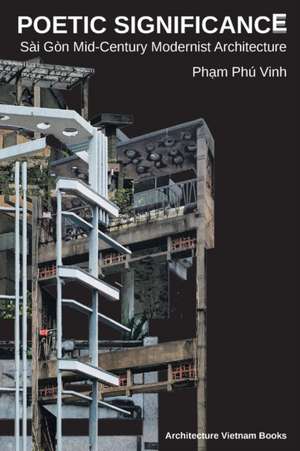Poetic Significance
Autor Pham Phu Vinhen Limba Engleză Paperback – 15 feb 2021
Preț: 135.87 lei
Nou
Puncte Express: 204
Preț estimativ în valută:
25.100€ • 26.97$ • 21.68£
25.100€ • 26.97$ • 21.68£
Carte disponibilă
Livrare economică 06-20 martie
Preluare comenzi: 021 569.72.76
Specificații
ISBN-13: 9781087943374
ISBN-10: 108794337X
Pagini: 308
Dimensiuni: 140 x 210 x 19 mm
Greutate: 0.38 kg
Editura: Architecture Vietnam Books
ISBN-10: 108794337X
Pagini: 308
Dimensiuni: 140 x 210 x 19 mm
Greutate: 0.38 kg
Editura: Architecture Vietnam Books
Notă biografică
Ph¿m Phú Vinh, Designer and Writer.Ph¿m Phú Vinh is a Vietnamese architect who earned his Bachelor degree at the University of Architecture of Ho Chi Minh city and is currently pursuing his post-graduate study at the École Nationale Supérieure d'Architecture et de Paysage de Bordeaux in France. Like many people in the influx of population moving to Ho Chi Minh City for either education or job opportunities, he was taken by the modern, open, vibrant and intensive identity of the city. With a foundation of languages, including Vietnamese, English and French, a voracious interest in history as well as involvement in different art forms, including painting, photography, videography and graphic design, Vinh has found Ho Chi Minh city "fertile" for discoveries. Trips on a motorbike in this city were where he discovered the remarkable mid-century modernist architecture in Ho Chi Minh city. He came to appreciate it for the distinctive architectural language produced by the culture that is, however, oftentimes overlooked. In 2018, Vinh filmed and produced the video "Saigon modernism - Unique features" that mapped and exposed this neglected language of which the very urban landscape of Saigon is made. He has led many walks around the city to introduce Vietnamese modernist architecture to people. Vinh attended the Lê V¿n Mi¿n art market in 2018 where he presented his postcards showing Ho Chi Minh city's significant modernist buildings. His articles "Decoding the Language of Vietnamese Modernist Architecture" and "T¿ khi nào ki¿n trúc Vi¿t Nam tr¿ nên hi¿n ¿¿i - When did Vietnamese architecture turn modern?" were published by the magazines Saigoneer and Urbanist Vietnam on 17 August 2021 and 25 September 2020. Ph¿m Phú Vinh's featured projects and research can be found at https://phamvinh.wixsite.com/featured/.
